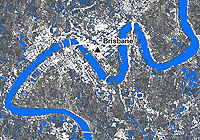Opinion: Satellite could warn on floods
Australia could have an early warning system that would let authorities predict flash floods and warn people in the path of danger, Associate Professor Linlin Ge says.
Australia could have an early warning system that would let authorities predict flash floods and warn people in the path of danger, Associate Professor Linlin Ge says.

Australia could have an early warning system to predict flash floods and give a timely warning to people in the path of danger with a relatively small investment, writes Associate Professor Linlin Ge, of the School of Surveying and Spatial Information Systems, in an opinion piece published in the National Times.
One of the great challenges in dealing with flooding over vast areas is knowing what the big picture looks like. Another challenge is getting that information quickly enough to make it useful to people working on the front lines of disaster response.
The best way to get that information is from space. Australia is one of the few developed nations not to have its own earth observation satellite or weather satellite. The most recent Defence White Paper identified the need for such a satellite. This is a big investment. But in the meantime a relatively small investment of about $5 million in a purpose-built satellite ground receiving station would give us the capacity that Australia urgently needs to effectively deal with natural disasters.
Since late December, researchers at UNSW's School of Surveying and Spatial Information Systems have been supplying Queensland emergency authorities with high-resolution satellite radar imagery of the flood zones. We have had to rely on radar images taken by earth observation satellites owned by the Italian space agency.
This has meant delays of up to six hours while our researchers wait for the satellites that have imaged the Australian disaster zone to pass over European ground stations to downlink their data. Our researchers then have to wait for the large volume of data, in the order of one to five gigabytes, to be decoded at the overseas facility and be delivered back to Australia via the internet so we can process the data into useable intelligence for our emergency authorities.
If we had our own receiving station we could obtain the data almost instantly. With our current capacity the overall delay could be comfortably reduced to less than three hours and, with some further research and development into automation of data processing, it could be cut to less than 30 minutes.
The full text of this extract can be read on the National Times.
UNSW TV: Ground control - disaster monitoring from above
Media Contact: Peter Trute, UNSW Media Office | 02 9385 1933 | p.trute@unsw.edu.au